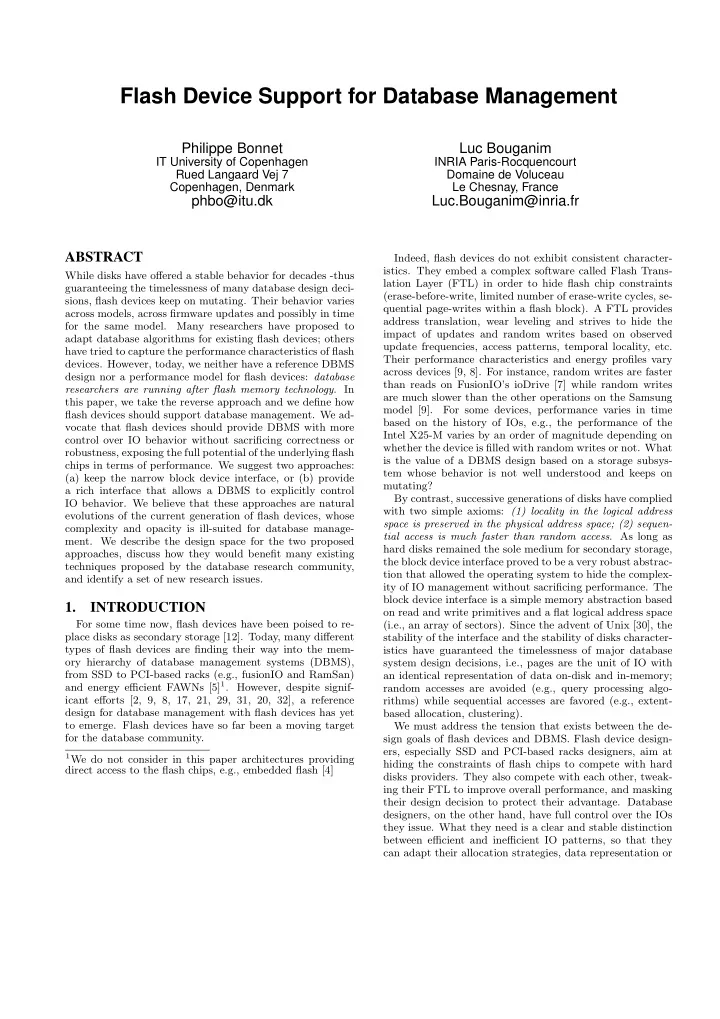

Flash Device Support for Database Management Philippe Bonnet Luc Bouganim IT University of Copenhagen INRIA Paris-Rocquencourt Rued Langaard Vej 7 Domaine de Voluceau Copenhagen, Denmark Le Chesnay, France Luc.Bouganim@inria.fr phbo@itu.dk ABSTRACT Indeed, flash devices do not exhibit consistent character- istics. They embed a complex software called Flash Trans- While disks have offered a stable behavior for decades -thus lation Layer (FTL) in order to hide flash chip constraints guaranteeing the timelessness of many database design deci- (erase-before-write, limited number of erase-write cycles, se- sions, flash devices keep on mutating. Their behavior varies quential page-writes within a flash block). A FTL provides across models, across firmware updates and possibly in time address translation, wear leveling and strives to hide the for the same model. Many researchers have proposed to impact of updates and random writes based on observed adapt database algorithms for existing flash devices; others update frequencies, access patterns, temporal locality, etc. have tried to capture the performance characteristics of flash Their performance characteristics and energy profiles vary devices. However, today, we neither have a reference DBMS across devices [9, 8]. For instance, random writes are faster design nor a performance model for flash devices: database than reads on FusionIO’s ioDrive [7] while random writes researchers are running after flash memory technology . In are much slower than the other operations on the Samsung this paper, we take the reverse approach and we define how model [9]. For some devices, performance varies in time flash devices should support database management. We ad- based on the history of IOs, e.g., the performance of the vocate that flash devices should provide DBMS with more Intel X25-M varies by an order of magnitude depending on control over IO behavior without sacrificing correctness or whether the device is filled with random writes or not. What robustness, exposing the full potential of the underlying flash is the value of a DBMS design based on a storage subsys- chips in terms of performance. We suggest two approaches: tem whose behavior is not well understood and keeps on (a) keep the narrow block device interface, or (b) provide mutating? a rich interface that allows a DBMS to explicitly control By contrast, successive generations of disks have complied IO behavior. We believe that these approaches are natural with two simple axioms: (1) locality in the logical address evolutions of the current generation of flash devices, whose space is preserved in the physical address space; (2) sequen- complexity and opacity is ill-suited for database manage- tial access is much faster than random access . As long as ment. We describe the design space for the two proposed hard disks remained the sole medium for secondary storage, approaches, discuss how they would benefit many existing the block device interface proved to be a very robust abstrac- techniques proposed by the database research community, tion that allowed the operating system to hide the complex- and identify a set of new research issues. ity of IO management without sacrificing performance. The block device interface is a simple memory abstraction based 1. INTRODUCTION on read and write primitives and a flat logical address space For some time now, flash devices have been poised to re- (i.e., an array of sectors). Since the advent of Unix [30], the place disks as secondary storage [12]. Today, many different stability of the interface and the stability of disks character- types of flash devices are finding their way into the mem- istics have guaranteed the timelessness of major database ory hierarchy of database management systems (DBMS), system design decisions, i.e., pages are the unit of IO with from SSD to PCI-based racks (e.g., fusionIO and RamSan) an identical representation of data on-disk and in-memory; and energy efficient FAWNs [5] 1 . However, despite signif- random accesses are avoided (e.g., query processing algo- icant efforts [2, 9, 8, 17, 21, 29, 31, 20, 32], a reference rithms) while sequential accesses are favored (e.g., extent- design for database management with flash devices has yet based allocation, clustering). to emerge. Flash devices have so far been a moving target We must address the tension that exists between the de- for the database community. sign goals of flash devices and DBMS. Flash device design- ers, especially SSD and PCI-based racks designers, aim at 1 We do not consider in this paper architectures providing hiding the constraints of flash chips to compete with hard direct access to the flash chips, e.g., embedded flash [4] disks providers. They also compete with each other, tweak- ing their FTL to improve overall performance, and masking their design decision to protect their advantage. Database designers, on the other hand, have full control over the IOs they issue. What they need is a clear and stable distinction between efficient and inefficient IO patterns, so that they can adapt their allocation strategies, data representation or
Recommend
More recommend